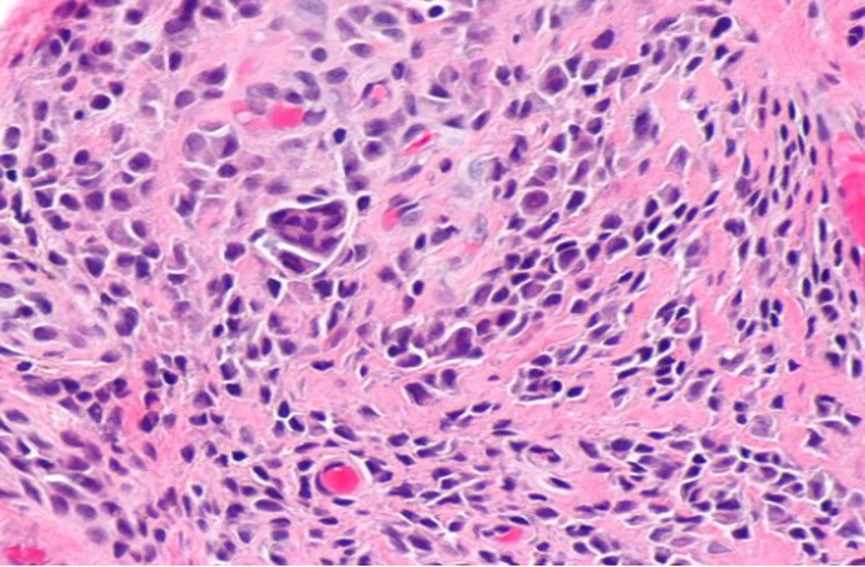Arch Hand Microsurg.
2021 Sep;26(3):161-165. 10.12790/ahm.21.0096.
Management of a Huge Tenosynovial Giant Cell Tumor of the Wrist
- Affiliations
-
- 1Department of Orthopaedic Surgery, Soonchunhyang University Cheonan Hospital, Cheonan, Korea
- 2Department of Nuclear Medicine, Soonchunhyang University Cheonan Hospital, Cheonan, Korea
- 3Department of Orthopaedic Surgery, Soonchunhyang University Bucheon Hospital, Bucheon, Korea
- 4Department of Orthopaedic Surgery, Soonchunhyang University Seoul Hospital, Seoul, Korea
- KMID: 2519468
- DOI: http://doi.org/10.12790/ahm.21.0096
Abstract
- Tenosynovial giant cell tumors (TGCTs) are typically benign neoplasms of the joint, bursa, and tendon sheath. Usually, TGCT presents as a small localized tumor on the hand and wrist. The diffuse-type TGCT is more aggressive and mainly affects large joints such as knees, hips, ankles, and elbows. Diffuse-type TGCT of small joints is rare. To our knowledge, this is a very rare case of a huge diffuse-type TGCT on the wrist. We report a huge TGCT, which grew gradually over 10 years.
Keyword
Figure
Reference
-
1. Lu H, Shen H, Chen Q, Shen XQ, Wu SC. Artificial finger joint replacement due to a giant cell tumor of the tendon sheath with bone destruction: a case report. Oncol Lett. 2015; 10:3502–4.
Article2. Zambo I, Veselý K. WHO klasifikace nádorů měkkých tkání a kostí 2013: hlavní změny oproti 3. vydání [WHO classification of tumours of soft tissue and bone 2013: the main changes compared to the 3rd edition]. Cesk Patol. 2014; 50:64–70. Czech.3. Zhao Q, Lu H. Giant cell tumor of tendon sheath in the wrist that damaged the extensor indicis proprius tendon: a case report and literature review. BMC Cancer. 2019; 19:1057.
Article4. Sansone V, Longhino V. What's in a name? A call for consistency in the classification of tenosynovial giant cell tumour. Knee. 2018; 25:1322–3.
Article5. Gouin F, Noailles T. Localized and diffuse forms of tenosynovial giant cell tumor (formerly giant cell tumor of the tendon sheath and pigmented villonodular synovitis). Orthop Traumatol Surg Res. 2017; 103:S91–7.
Article6. Hoch BL, Garcia RA, Smalberger GJ. Chondroid tenosynovial giant cell tumor: a clinicopathological and immunohistochemical analysis of 5 new cases. Int J Surg Pathol. 2011; 19:180–7.
Article7. Rockberg J, Bach BA, Amelio J, et al. Incidence trends in the diagnosis of giant cell tumor of bone in Sweden since 1958. J Bone Joint Surg Am. 2015; 97:1756–66.
Article8. Fraser EJ, Sullivan M, Maclean F, Nesbitt A. Tenosynovial giant-cell tumors of the foot and ankle: a critical analysis review. JBJS Rev. 2017; 5:01874474-201701000-00001.
Article9. Mastboom MJ, Palmerini E, Verspoor FGM, et al. Surgical outcomes of patients with diffuse-type tenosynovial giant-cell tumours: an international, retrospective, cohort study. Lancet Oncol. 2019; 20:877–86.10. Murphey MD, Rhee JH, Lewis RB, Fanburg-Smith JC, Flemming DJ, Walker EA. Pigmented villonodular synovitis: radiologic-pathologic correlation. Radiographics. 2008; 28:1493–518.
Article11. West RB, Rubin BP, Miller MA, et al. A landscape effect in tenosynovial giant-cell tumor from activation of CSF1 expression by a translocation in a minority of tumor cells. Proc Natl Acad Sci U S A. 2006; 103:690–5.
Article12. Staals EL, Ferrari S, Donati DM, Palmerini E. Diffuse-type tenosynovial giant cell tumour: current treatment concepts and future perspectives. Eur J Cancer. 2016; 63:34–40.
Article13. Kan JH, Hernanz-Schulman M, Damon BM, Yu C, Connolly SA. MRI features of three paediatric intra-articular synovial lesions: a comparative study. Clin Radiol. 2008; 63:805–12.
Article14. Chen EL, de Castro CM 4th, Hendzel KD, et al. Histologically benign metastasizing tenosynovial giant cell tumor mimicking metastatic malignancy: a case report and review of literature. Radiol Case Rep. 2019; 14:934–40.
Article15. Roeder F, Timke C, Zwicker F, et al. Intensity modulated radiotherapy (IMRT) in benign giant cell tumors--a single institution case series and a short review of the literature. Radiat Oncol. 2010; 5:18.
Article16. Healey JH, Bernthal NM, van de Sande M. Management of tenosynovial giant cell tumor: a neoplastic and inflammatory disease. J Am Acad Orthop Surg Glob Res Rev. 2020; 4:e20.00028.
Article17. Mollon B, Lee A, Busse JW, et al. The effect of surgical synovectomy and radiotherapy on the rate of recurrence of pigmented villonodular synovitis of the knee: an individual patient meta-analysis. Bone Joint J. 2015; 97-B:550–7.18. Horoschak M, Tran PT, Bachireddy P, et al. External beam radiation therapy enhances local control in pigmented villonodular synovitis. Int J Radiat Oncol Biol Phys. 2009; 75:183–7.
Article19. Stephan SR, Shallop B, Lackman R, Kim TW, Mulcahey MK. Pigmented villonodular synovitis: a comprehensive review and proposed treatment algorithm. JBJS Rev. 2016; 4:01874474-201607000-00005.20. Tap WD, Wainberg ZA, Anthony SP, et al. Structure-guided blockade of CSF1R kinase in tenosynovial giant-cell tumor. N Engl J Med. 2015; 373:428–37.
Article21. Palmerini E, Staals EL, Maki RG, et al. Tenosynovial giant cell tumour/pigmented villonodular synovitis: outcome of 294 patients before the era of kinase inhibitors. Eur J Cancer. 2015; 51:210–7.
Article
- Full Text Links
- Actions
-
Cited
- CITED
-
- Close
- Share
- Similar articles
-
- Tenosynovial Giant-cell Tumor of the Lumbar Spine
- A Tenosynovial Giant Cell Tumor Arising from Femoral Attachment of the Anterior Cruciate Ligament
- Tenosynovial Giant Cell Tumor Showing Severe Bone Erosion in the Finger: Case Report and Review of the Imaging Findings and Their Significance
- Retropharyngeal Tenosynovial Giant Cell Tumor Misdiagnosed as Oropharyngeal Cancer: a Case Report
- Tenosynovial Giant Cell Tumor of the Temporomandibular Joint




